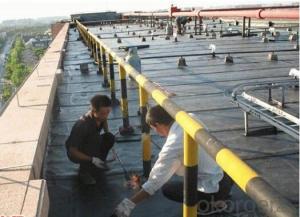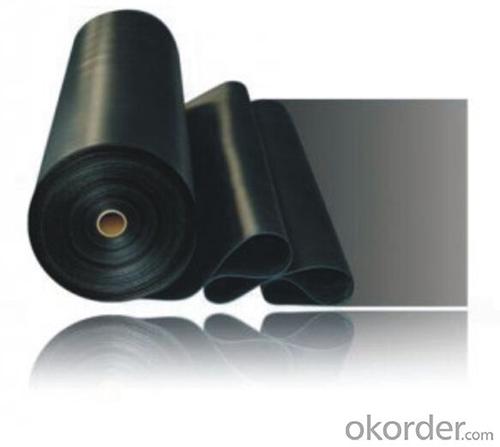Width 2m EPDM Waterproofing Membrane for Pond Use
- Loading Port:
- Qingdao
- Payment Terms:
- TT OR LC
- Min Order Qty:
- 2000 m²
- Supply Capability:
- 100000 m²/month
OKorder Service Pledge
OKorder Financial Service
You Might Also Like
EPDM waterproofing Rubber membrane
1. Product Description of EPDM Waterproofing Membrane:
EPDM Waterproofing Membrane is the modified materials which is widely used at home and abroad in the kinds of roofs, tunnel, basement such sorts of constructions' waterproofing.
They are based upon EPDM rubber with modifier, softener and accelerant assistants added to provide flexibility and stability . Through the precise ingredients, mixing, extrusion, rolling, curing processes to made of modified EPDM Waterproofing material with high strength and high flexibility.
2. Product Features of EPDM Waterproofing Membrane:
1). Great tensile strength,long-range elasticity and aging resistant.
2). Excellent heat reisistant and can be used under -70°C~~+110°C .
3).Good anti-corrosion, ultraviolet resistant, root penetration resistance
4).Long life use over 50 years and used longer 100 years or more under the condition of buried in the ground.
5).Light and easy to install.
3. Product Sepcification of EPDM Waterproofing Membrane:
Thickness : 0.3-2.0mm
Width :1-4m
Length: 15-50m/roll
Item | value | ||
JL1 | JF1 | ||
Tensile Strength (Mpa) | normal tamperature | 7.5 | 4.0 |
60°C ≥ | 2.3 | 0.8 | |
Elongation at break (%) | normal tamperature ≥ | 450 | 450 |
-20°C ≥ | 200 | 200 | |
Tear Resistance (N) | ≥ | 25 | 18 |
Water impermeability | 30mm | 0.3Mpa | 0.3Mpa |
Cold bending | (°C) ≤ | -40 | -30 |
Heating Shrinking rate | extand << span=""> | 2 | 2 |
shrink << span=""> | 4 | 4 | |
4.Product Application of EPDM Waterproofing Membrane:

4. Some photos:


- Q: Can a waterproofing membrane be used on stainless steel surfaces?
- Yes, a waterproofing membrane can be used on stainless steel surfaces. The membrane helps to prevent water penetration and protect the stainless steel from corrosion or damage caused by moisture.
- Q: Can a waterproofing membrane be used on wood block surfaces?
- Yes, a waterproofing membrane can be used on wood block surfaces. The membrane acts as a protective barrier, preventing water penetration and potential damage to the wood. It is a common practice to use waterproofing membranes on wood block surfaces in order to enhance their durability and longevity.
- Q: Can a waterproofing membrane be installed by a homeowner or is professional installation necessary?
- A waterproofing membrane can technically be installed by a homeowner, but it is highly recommended to have professional installation for optimal results. Waterproofing membranes are designed to protect buildings from water damage and require proper installation techniques and expertise to ensure their effectiveness. Professional installers have the knowledge and experience to properly assess the needs of the specific project, select the appropriate type of membrane, and install it correctly. They understand the best methods for surface preparation, membrane application, and seam sealing to create a watertight barrier. Additionally, professional installers have access to specialized equipment and tools that may be necessary for the installation process. They can also provide warranties or guarantees for their work, providing homeowners with peace of mind and protection in case any issues arise in the future. While it may seem possible for a homeowner to attempt the installation themselves, any mistakes or improper installation techniques could result in water leaks, mold growth, or other costly damages. It is always better to invest in professional installation to ensure that the waterproofing membrane functions as intended and provides long-term protection for the building.
- Q: Does a waterproofing membrane prevent water vapor transmission?
- Yes, a waterproofing membrane is designed to prevent both liquid water and water vapor from penetrating through a surface. It acts as a barrier that blocks the movement of moisture, including water vapor, thus preventing water intrusion and potential damage to the underlying structure. Waterproofing membranes are commonly used in various applications such as roofs, basements, and bathrooms to ensure the integrity and durability of the building envelope.
- Q: Can a waterproofing membrane be used on precast zinc surfaces?
- Precast zinc surfaces can indeed benefit from the use of a waterproofing membrane. These membranes are specifically designed to safeguard various surface types against water infiltration, including concrete, metal, and zinc. By creating a protective barrier, these membranes effectively prevent water from permeating the surface. This is especially crucial for precast zinc surfaces that are prone to exposure to moisture or water. The application of a waterproofing membrane to such surfaces can effectively extend their lifespan and shield them against potential water-induced damage, such as corrosion or deterioration. Therefore, it is essential to carefully choose a waterproofing membrane that is compatible with zinc and meticulously adhere to the manufacturer's instructions regarding proper application and maintenance.
- Q: Can a waterproofing membrane be used for a school building foundation?
- A school building foundation can indeed utilize a waterproofing membrane. These membranes are specifically created to safeguard structures by preventing water from infiltrating. They are commonly employed in various construction scenarios, including building foundations. By applying a waterproofing membrane to the foundation walls, it can effectively shield the building from water-related harm and prevent issues caused by moisture, such as mold, decay, and structural damage. This is especially crucial for school buildings due to their extensive foundations and the possibility of heavy usage and water exposure. Thus, the use of a waterproofing membrane is a viable solution to ensure the durability and structural soundness of the school building foundation.
- Q: Can a waterproofing membrane be used on precast concrete block surfaces?
- Precast concrete block surfaces can benefit from the application of a waterproofing membrane. These membranes are commonly used to safeguard below-grade structures, like basements and foundations, from water infiltration. When constructing these structures, precast concrete blocks are frequently utilized, and the use of a waterproofing membrane can prevent water from seeping into the concrete and causing harm. The membrane acts as a barrier, prohibiting water from passing through while still allowing the concrete to breathe and release any accumulated moisture. Furthermore, waterproofing membranes can enhance the overall durability and lifespan of precast concrete blocks by shielding them from moisture-related problems such as cracking, spalling, and corrosion. It is crucial to select a waterproofing membrane that is specifically designed for below-grade applications and is compatible with concrete surfaces to ensure proper adhesion and long-term efficacy.
- Q: Is a waterproofing membrane resistant to hydrocarbons or oils?
- Yes, a waterproofing membrane is generally resistant to hydrocarbons or oils. The materials used in waterproofing membranes, such as bitumen or synthetic polymers, are typically designed to have high resistance to various chemicals, including hydrocarbons and oils. This resistance helps to ensure that the membrane remains effective in preventing water penetration even in the presence of these substances. However, it is important to note that the specific resistance level may vary depending on the type and quality of the waterproofing membrane. It is always recommended to consult the manufacturer or supplier to determine the exact resistance capabilities of a specific waterproofing membrane.
- Q: Can a waterproofing membrane be used in conjunction with flooring materials?
- Yes, a waterproofing membrane can be used in conjunction with flooring materials. In fact, it is often recommended to use a waterproofing membrane when installing certain types of flooring, such as in wet areas like bathrooms, kitchens, or basements. A waterproofing membrane acts as a barrier against moisture, preventing water from seeping through and damaging the flooring material or the subfloor. It helps to protect the flooring from leaks, spills, or even excessive moisture in the air. By using a waterproofing membrane, you can ensure the longevity and durability of your flooring, while also maintaining a waterproof and moisture-resistant environment.
- Q: Can a waterproofing membrane be used in stadiums or sports complexes?
- Yes, a waterproofing membrane can be used in stadiums or sports complexes to protect the structural elements from water damage and prevent leaks.
Send your message to us
Width 2m EPDM Waterproofing Membrane for Pond Use
- Loading Port:
- Qingdao
- Payment Terms:
- TT OR LC
- Min Order Qty:
- 2000 m²
- Supply Capability:
- 100000 m²/month
OKorder Service Pledge
OKorder Financial Service
Similar products
Hot products
Hot Searches
Related keywords



























